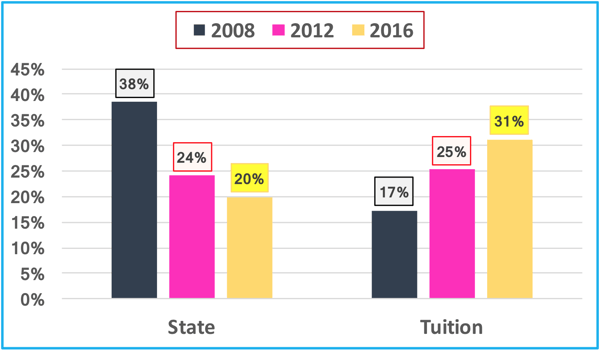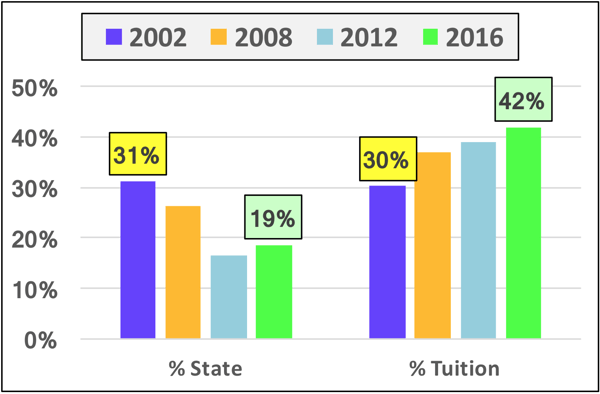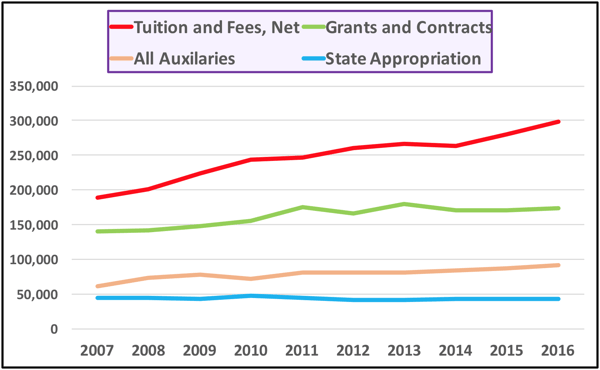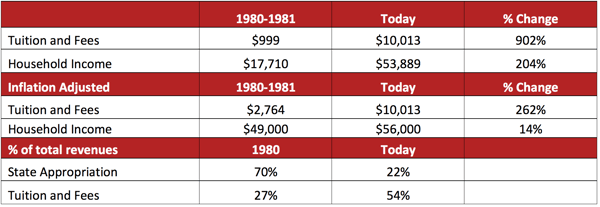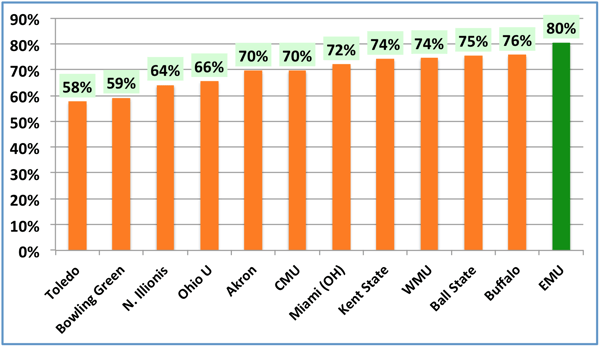Published on
Bandaid Solutions Cannot Be the Long-Term Fix: Addressing Public Higher Ed’s Budgetary Challenges

Public colleges and universities today are operating in challenging times. State appropriations are declining but students expect more and more from their institutions. This makes for tough budgetary positions and, according to the American Association of University Professors (AAUP) 2016-2017 Annual Report on the Economy Status of the Profession, this has led to an increased reliance on out-of-state enrollments and part-time faculty. Unfortunately, both these trends—though effective in the short-term at making ends meet—could have negative long-term ramifications. What’s needed is to move on from the status quo to actually address these challenges head-on. In this interview, Howard Bunsis shares his thoughts on how these trends could be damaging to public higher education in the United States and reflects on critical changes that must be made at the institutional level to truly adapt.
The EvoLLLution (Evo): What are a few of the factors that are leading to budgetary challenges for public colleges and universities?
Howard Bunsis (HB): The main challenge is the decline in the state appropriation. What this has led to is an over-reliance on tuition, which makes it very hard for students and their families to succeed.
Below is a graph of the percentage of revenues from tuition and the state for all Louisiana public universities over time:
As you can see, in 2008, the state was 38 percent of total revenues, and tuition was 17 percent. By 2016, the state was only 20 percent of total revenues, and tuition was 31 percent.
The graph below is the revenue distribution for Western Michigan University:
The table below is the revenue distribution for the University of Vermont over time:
As you can see, tuition keeps growing and growing, while the state appropriation is flat or even declining
The last example is the appropriation on a per-student basis, and the graph below is for all the public institutions in Kentucky. This graph maps the percentage change from 2008 to 2016 in enrollments, state appropriations and appropriations per student:
What we see in Kentucky is an increase in enrollment from 2008 to 2016, a decline in the appropriation and a very large decline in the appropriation per student.
Evo: What are the fundamental problems with the growing institutional reliance on part-time and adjunct faculty?
HB: There are a few fundamental problems with this approach.
First, the part time faculty themselves are not well compensated. They have very little or no security, most have no health benefits, and most have no retirement benefits. In addition, in order just to make ends meet, the part-time faculty often have to work at several institutions. Lastly, part-time faculty are not given sufficient notice on when they will be teaching, and this group of hard-working and dedicated faculty members do not have the academic freedom and governance rights of full-time faculty members. Therefore, universities are relying on workers who are simply not treated appropriately.
Second, given the working conditions of part-time faculty (many do not even have phones or offices), students are not getting the support and mentoring that they need from faculty. Our students today have it harder than ever before. Given the extraordinary growth in the price of tuition, students have to work—often full-time and at several jobs—just to afford their education. Our students need more mentoring and assistance than ever, but due to the poor working conditions of part-time faculty, the students are not getting the support they need and deserve.
This is not a criticism of part-time faculty members—these part-time faculty members are totally dedicated to their students and are true professionals. However, part time faculty members do not have the time and space needed to truly help the students.
Evo: In the report, you point out that public colleges and universities are relying on more enrollments from out-of-state students. Why is this problematic?
HB: For many students, the only way they and their families can afford to go to a four-year institution is to go to a public in-state university. However, since universities are keeping fewer and fewer spots for in-state residents, they are making it very difficult for many students to even have a chance for a four-year degree.
If a student is shut out from the public institutions in the state, there are few options:
- Going to a public institution in another state means paying two to three times the tuition as an in-state student
- Going to a private institution—either in the state or elsewhere—is incredibly expensive.
The majority of our students who attend four-year institutions attend a school in their home state. If those doors are closed, then we are closing the door of college on the largest group of citizens in our states.
Evo: What are the critical changes that need to happen in order for these trends to be reversed?
HB: There are several changes that need to occur in order to reverse these trends around relying on poorly compensated part-time faculty and relying upon out-of-state enrollments to make ends meet.
First, we need a national commitment to making higher education affordable. In New York, an agreement was reached for free tuition for SUNY and CUNY for most students (based on income under $125,000, which is the vast majority of students). In California, there is a group supporting free public higher education, which we at the AAUP support. Ultimately, these are trends we would like to see this happen at the national level.
Secondly, along with tuition support, we need more state-level support for public higher education. This will ease the burden of high tuition on students and their families. The table below is for the institution where I am an accounting professor, Eastern Michigan University:
The other large change that needs to take place is the misplaced priorities of university administrations. There are not enough resources devoted to the core academic mission, and way too many resources devoted to administration. Put simply, there are too many administrators making too much money.
Additionally, at most public institutions—other than about 20 to 25 public institutions that are particularly successful—intercollegiate athletics are a huge drain of resources from the core academic mission. At most of our public institutions, students and their families have to subsidize athletics. Going back to my home institution’s example, the proportion of subsidization of the athletic budget at Eastern Michigan compares to other Mid-American Conference (MAC) universities (source: USA Today for 2015) as follows:
This graph shows that in the Mid-American Conference, every institution needs the core academic side of the university to cover at least 58 percent of total athletic expenses. Why? Because athletic revenues are so low, and athletic expenses are so high.
This interview expands on the findings from the American Association of University Professors (AAUP) 2016-2017 Annual Report on the Economy Status of the Profession.
Author Perspective: Association

